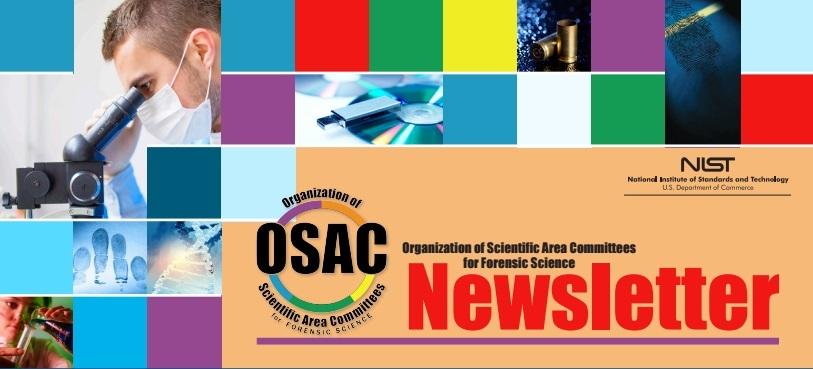OSAC Newsletter, May 2016

May 2016
In Remembrance of Connie Borror | Voluntary Consensus Standards: American National Standards | Status of Standards/Guidelines Recommended for Inclusion on OSAC Registries | Research & Development Needs | Message from the OSAC Affairs Director: OSAC Annual Report | On the Horizon | Standards Development News | Message from the FSSB: OSAC Vacancies Related to Expiring 2-Year Terms | OSAC Catalog of External Standards and Guidelines
In Remembrance of Connie Borror

|
Among a wide range of volunteer efforts within the statistical community, Connie volunteered to serve on the Toxicology Subcommittee in the OSAC. She was a confident yet diplomatic statistician who looked forward to working with forensic scientists in an application area that was new to her. She was among the first to draw everyone together and to look for solutions to problems that were workable for all.
Connie was a Professor in the Division of Mathematical and Natural Sciences at Arizona State University West. She earned her Ph.D. in Industrial Engineering from Arizona State University in 1998 and joined the Division of Mathematical and Natural Sciences in 2005. Her research interests included experiment design, measurement systems analysis, response surface methods, and statistical process control. She co-authored two books and over 60 journal articles in these areas. Connie was a Fellow of the American Statistical Association and of the American Society for Quality. She served as the director of the Certificate in Statistics Program and co-director of the Committee on Statistics at ASU.
Connie was a proactive research collaborator, initiating contacts and working with colleagues from different parts of ASU and from many other organizations including Los Alamos National Laboratory, University of Wyoming, Technical University of Denmark, Virginia Tech, and Cukurova University in Turkey. Her strong collaborative record demonstrated her ability to unite with people from many different fields and backgrounds.
Among a number of other important awards, Connie was recently recognized by the American Society for Quality with the Walter Shewhart Medal for "outstanding leadership, teaching and research in the development and application of statistical techniques for engineering and industrial needs in the areas of response surface design, robust parameter design, measurement system and quality control." Although Connie was the 67th recipient of the award, she was the first woman ever to receive the distinction.
Will Guthrie, Chief of the Statistical Engineering Division at NIST, knew and worked with Connie in various professional associations in addition to the OSAC. He recently noted that he remembers Connie as an excellent statistician who contributed greatly to all of the activities she undertook. She was always interested in helping other people, especially through the teaching and mentoring of students and via professional support of her colleagues.
Feature Article
Voluntary Consensus Standards: American National Standards
By Anne Caldas

Standards and guidelines approved for inclusion on the OSAC Registries must be developed by a process that follows the four core OSAC principles: Openness, Balance, Consensus within the OSAC, and Harmonization. Read more about the OSAC Core Principles in the OSAC Charter, Bylaws, and Terms of Reference.
OMB A-119 Federal Participation in the Development and Use of Voluntary Consensus Standards and in Conformity Assessment Activities includes a definition of voluntary consensus standards (VCS). American National Standards (ANS) embody this definition. For a standard to be approved as an ANS, it must be advanced by an ANSI-Accredited Standards Developer (ASD), and developed through an open consensus process, with meaningful and fair opportunities for all stakeholders to contribute.
Let's talk about what this means. The "ANSI Essential Requirements: due process requirements for American National Standards" provides the roadmap to approval of a standard as an ANS. The consensus process must include outreach to engage a balance of stakeholders on the group that votes on the content of the standard, i.e., ANS consensus body, and must be free from dominance by any single interest. All ANS also comply with ANSI's patent policy. ASDs are required to maintain written and publicly available procedures, undertake meaningful notice of standards development activities and ensure consideration of timely comments – including those submitted by the public through required public comment opportunities, such as those published in ANSI's Standards Action.
ANSI's ANS procedures also establish specific mechanisms to address conflict and require a fair and accessible procedural appeals process – first through the ASD and then through ANSI. Unique to the ANS process is the ANSI audit: ANS are subject to ANSI's impartial and routine procedural audit process – in addition to other procedural checks and balances. This notion of fairness permeates ANSI's rules and indeed ANSI's ANS governance bodies too are subject to conflict of interest procedures with respect to their ANS decision-making responsibilities. Taken together, all of these checks and balances result in a voluntary consensus standards process that is fair, accessible and results in standards that advance innovation, safety and the public health.
As the bridge between public-sector policies and private-sector solutions, ANSI has a vital role to play in strengthening U.S. competitiveness and quality of life. As the coordinator of the U.S. voluntary consensus standards system, which includes the ANS process, ANSI serves as a facilitator, providing an infrastructure and process by which proposed American National Standards (ANS) may be vetted and other standardization issues addressed. ANSI's role is to safeguard the integrity of this system, which by design, is based on a private-public partnership that is driven by the needs of the range of markets in this country and by the public interest.
The integrity and inclusiveness of the ANS process results in high quality standards that help to protect the public and foster commerce. Consistent with our democratic principles, everyone who chooses to participate in the ANS process can have a voice. Consensus and comment consideration in a due process based (fair) environment lead to standards that will be better accepted and more widely used. On almost any given day, a standards group or technical committee (consensus body) is meeting and making decisions that affect the bottom line of our national economy, safety and innovation. Broad engagement in this process is important - the ANS process gives everyone a chance to be heard and to contribute to standards-based solutions for a strong nation and a safer, healthier world.
When you think about voluntary consensus standards – and American National Standards – consider that the openness, fairness and diversity of the underlying process make the U.S. standards system stronger. Voluntary consensus standards spur and support innovation, are responsive to human and market needs, facilitate economic growth and productivity, and keep us competitive. Participate in the ANS process – and have your voice heard.
Resources:
• List of ANSI-Accredited Standards Developers
• ANSI Essential Requirements: Due process requirements for American National Standards
• Value of American National Standards Designation
Questions? Anne Caldas, ANSI, acaldas [at] ansi.org (acaldas[at]ansi[dot]org)
Status of Standards/Guidelines Recommended for Inclusion on OSAC Registries
Standards and Guidelines Open for Public Comment
The intent of the public comment period is to collect public opinion on inclusion of the standard to the OSAC Registry (OSAC is not soliciting potential revisions to the documents themselves.)
No items are currently open for public comment.
Standards and Guidelines in Public Comment Adjudication Phase
Public comment period is closed for the following standards/guidelines as OSAC units review and adjudicate comments received.
ASTM: E2881-13e1 Standard Test Method for Extraction and Derivatization of Vegetable Oils and Fats from Fire Debris and Liquid Samples with Analysis by Gas Chromatography-Mass Spectrometry (for consideration as an OSAC Standard)
This test method covers the extraction, derivatization, and identification of fatty acids indicative of vegetable oils and fats in fire debris and liquid samples. This procedure will also extract animal oils and fats, as these are similar in chemical composition to vegetable oils and fats. Herein, the phrase "oils and fats" will be used to refer to both animal and vegetable derived oils and fats. This test method is suitable for successfully extracting oil and fat residues having 8 to 24 carbon atoms.
ASTM: E1610-14 Standard Guide for Forensic Paint Analysis and Comparison (for consideration as an OSAC Guideline)
This guide is designed to assist the forensic paint examiner in selecting and organizing an analytical scheme for identifying and comparing paints and coatings. The size and condition of the sample(s) will influence the selected analytical scheme.
ASTM: E2937-13 Standard Guide for Using Infrared Spectroscopy in Forensic Paint Examinations (for consideration as an OSAC Guideline)
This guide applies to the forensic IR analysis of paints and coatings and is intended to supplement information presented in ASTM E1610 "Standard Guide for Forensic Paint Analysis and Comparison". This guideline is limited to the discussion of Fourier Transform Infrared (FTIR) instruments and provides information on FTIR instrument setup, performance assessment, sample preparation, analysis and data interpretation.
ASTM: E2388-11 Standard Guide for Minimum Training Requirements for Forensic Document Examiners (for consideration as an OSAC standard)
This guide may not cover all aspects of training for the topics addressed or for unusual or uncommon examinations.
Standards and Guidelines at FSSB for Vote
ASTM: E2330-12 Standard Test Method for Determination of Concentrations of Elements in Glass Samples Using Inductively Coupled Plasma Mass Spectrometry (ICP-MS) for Forensic Comparisons (for consideration as an OSAC Standard)
One objective of a forensic glass examination is to compare glass samples to determine if they can be discriminated using their physical, optical or chemical properties (for example, color, refractive index (RI), density, elemental composition). If the samples are distinguishable in any of these observed and measured properties, it may be concluded that they did not originate from the same source of broken glass. If the samples are indistinguishable in all of these observed and measured properties, the possibility that they originated from the same source of glass cannot be eliminated. The use of an elemental analysis method such as inductively coupled plasma mass spectrometry yields high discrimination among sources of glass. This test method covers a procedure for quantitative determination of the concentrations of magnesium (Mg), aluminum (Al), iron (Fe), titanium (Ti), manganese (Mn), rubidium (Rb), strontium (Sr), zirconium (Zr), barium (Ba), lanthanum (La), cerium (Ce), neodymium (Nd), samarium (Sm), and lead (Pb) in glass samples.
ASTM: E2548-11e1 Standard Guide for Sampling Seized Drugs for Qualitative and Quantitative Analysis (for consideration as an OSAC Standard)
This guide covers minimum considerations for sampling of seized drugs for qualitative and quantitative analysis.
ASTM: E2926-13 Standard Test Method for Forensic Comparison of Glass Using Micro X-ray Fluorescence (μ-XRF) Spectrometry (for consideration as an OSAC Standard)
This test method is for the determination of major, minor, and trace elements present in glass fragments. The elemental composition of a glass fragment can be measured through the use of μ-XRF analysis for comparisons of glass. This test method covers the application of μ-XRF using mono- and poly- capillary optics, and an energy dispersive X-ray detector (EDS).
Standards and Guidelines in the Appeals Phase
The public appeals phase is open for the following standard. Appeals may only be submitted by individuals or groups that submitted a comment during the open public comment phase that believe their comment was not properly adjudicated. Submitted appeals must relate to the comment adjudication process, not technical issues.
No items are currently in the public appeals phase.
Registry Approval Standards and Guidelines routed to SDO for Updates
The Digital/Multimedia SAC decided to initiate revisions in ASTM on ASTM E2916-13 and ASTM E2825-12 after reviewing and considering the comments from the public and resource committees. They believe the issues raised during the comment period can be addressed in the ASTM subcommittee and intend to bring the updated standards back through the OSAC Registry Approval Process.
ASTM: E2916-13 Standard Terminology for Digital and Multimedia Evidence Examination (for consideration as an OSAC Guideline)
This document provides standard terminology for the subcommittees of Digital Evidence, Facial Identification, and Video Imaging Technology and Analysis.
ASTM: E2825-12 Standard Guide for Forensic Digital Image Processing (for consideration as an OSAC Standard)
This document provides digital image processing guidelines to ensure the production of quality forensic imagery for use as evidence in a court of law. It briefly describes advantages, disadvantages, and potential limitations of each major digital imaging process.

Twenty-two Research & Development needs have been added to the various subcommittees under the Physics/Pattern Interpretation SAC.They are:
Under Bloodstain Pattern Analysis:
Behavior of Blood Outside the Body
- Addendum to Behavior of Blood Outside the Body
Interaction of Blood and Fabrics
- Addendum to Interaction of Blood and Fabrics
Under Firearms & Toolmarks:
Assessment of Examiners' Toolmark Categorization Accuracy
Blind Verifications Needs Assessment
Cognitive Bias: To What Extent Does It Affect Firearm and Toolmark Comparison Outcomes
Effect of New Technology on Quantitative Consecutive Matching Striae ID Criteria
Study to Assess the Accuracy and Reliability of Firearms and Toolmarks
Under Footwear and Tire:
Examiner Reliability Study: Black/White Box Study on Footwear and Tire Examiners
National Footwear Database/Reference Collection
Population Frequency of Class Characteristics: Footwear in the United States
Probability of Randomly Acquired Characteristics
Testing & Validation of 3D Imaging Technologies for Footwear & Tire Impressions Evidence
Under Forensic Document Examination:
Comparability and Complexity in Handwriting
Hand Printing Complexity and Comparability
National Database of Handwriting
Validation of Conclusion Scale
Under Friction Ridge:
Assessing the Sufficiency and Strength of Friction Ridge Features
Examiner Consistency During Friction Ridge Feature Mark-Up
Friction Ridge Statistical Modeling
Latent Fingerprint Image Quality Usage
Research & Development Needs can be found in greater detail on the NIST OSAC Research and Development Needs page.
Message from the OSAC Affairs Director: OSAC Annual Report

|
The OSAC Annual Report, to be published in June 2016, will describe the annual achievements of the OSAC. The report will describe consolidated metrics as well as individual committee metrics, and other activities. The report will primarily encompass and summarize activities in between February 2015-February 2016.

(OSAC Meetings for OSAC Members and Invited Guests) The next full OSAC meetings are scheduled for summer 2016 in Phoenix, AZ. Instead of meeting as one large group, the OSAC will meet separately in a series of smaller meetings.
o (OSAC Meeting Breakout #1) Legal Resource Committee, Quality Infrastructure Committee, and Human Factors Committee, Jul 12-13, 2016
o (OSAC Meeting Breakout #2) Digital/Multimedia SAC + 4 Subcommittees, Physics/Pattern SAC + 5 Subcommittees, Jul 26-29, 2016
o (OSAC Meeting Breakout #3) Chemistry SAC + 6 Subcommittees, Aug 2-5, 2016
o (OSAC Meeting Breakout #4) Biology/DNA SAC + 3 Subcommittees, and Crime Scene SAC + 7 Subcommittees, Aug 23-26, 2016
o (OSAC Meeting for OSAC Members and Invited Guests) The following full OSAC meeting is scheduled for April 3-7, 2017, tentatively in Leesburg, VA.
o OSAC public meeting date and times will be announced shortly.
The Academy Standards Board (ASB) of the American Academy of Forensic Sciences (AAFS) is an ANSI-accredited Standards Development Organization. It is announcing the formation of Consensus Bodies. Each will have 7 to 25 members based on applications received. Members will be selected by the Board of Directors of the ASB. The ASB has eight interest categories, applicants are encouraged to apply in their self-selected interest category. A person may apply to one or more Consensus Bodies, and need not indicate the same interest category for each Consensus Body application. The Documents & Forms tab of the ASB website also contains links to several relevant documents describing the ASB. Applicants are requested to submit forms to be considered for serving on any of the Consensus Bodies. Contact asb [at] aafs.org (asb[at]aafs[dot]org) with any questions.
When filling out the Application for a Consensus Body, there is a section concerning Interest Groups. The form also requires choosing a Consensus Body (LINK EXPIRED). The Consensus Bodies currently accepting applications are as follows (please note the application closing date):
• Dogs and Sensors – May 17, 2016
Interested parties should fill out an online application to become a member of an ASB Consensus Body.
Standards in Development – Recent Activities
This section lists recent activities by standards developing organizations (SDOs) related to the development of voluntary consensus standards. OSAC encourages staying abreast of new developments in standards, and engaging directly with the SDO by participating in a task group or subcommittee. Published standards that meet the OSAC requirements for process and technical merit can be recommended for inclusion on the OSAC Registries.
ASTM Committee E30 on Forensic Sciences March/April 2016 Activity
ASTM Subcommittee E30.01 on Criminalistics
Revised Standard: E2123-16 Standard Practice for Transmittal of Evidence in Sexual Assault Investigation
Message from the FSSB: OSAC Vacancies Related to Expiring 2-Year Terms

NIST's Organization of Scientific Area Committees (OSAC), the 540-member group working to develop a uniform set of forensic science standards and guidelines, is seeking to fill vacancies on its boards and committees. Vacancies will be available because a number of memberships with 2-year terms expire this October. If the current member is interested in seeking a second term, they will be considered for the vacancy along with all other applicants that express interest in serving. Those who are interested and have not previously applied must submit an application in order to be eligible. Complete the online application form. Applications submitted by June 15, 2016, will be considered for the positions opening in October. All applications will be kept on file for future vacancies and affiliate roles.
OSAC Catalog of External Standards and Guidelines
Visit the OSAC Catalog of External Standards and Guidelines page
Version 3 of the Catalog has been posted to the OSAC website. The OSAC Catalog of External Standards and Guidelines is a collection of standards, guidelines and other documents applicable to forensic science. None of the documents in the catalog have been developed or approved by OSAC (the Organization of Scientific Area Committees). The catalog was compiled by NIST staff in early 2015 for OSAC members to assess existing standards, guidelines and best practices that are already publicly available. The catalog was recently updated in April of 2016. The catalog is available to download as a sortable Excel spreadsheet file (link opens an Excel .xlsx file). It contains the titles and source information for more than 700 standards, guidelines and related documents. The catalog also lists web addresses for documents that are available online.
The OSAC newsletter is produced monthly by OSAC Affairs at NIST with input from the FSSB and other OSAC members. Any mention of commercial products is for information only; it does not imply recommendation or endorsement by NIST. Contact forensics [at] nist.gov (forensics[at]nist[dot]gov) with comments or general inquiries.

